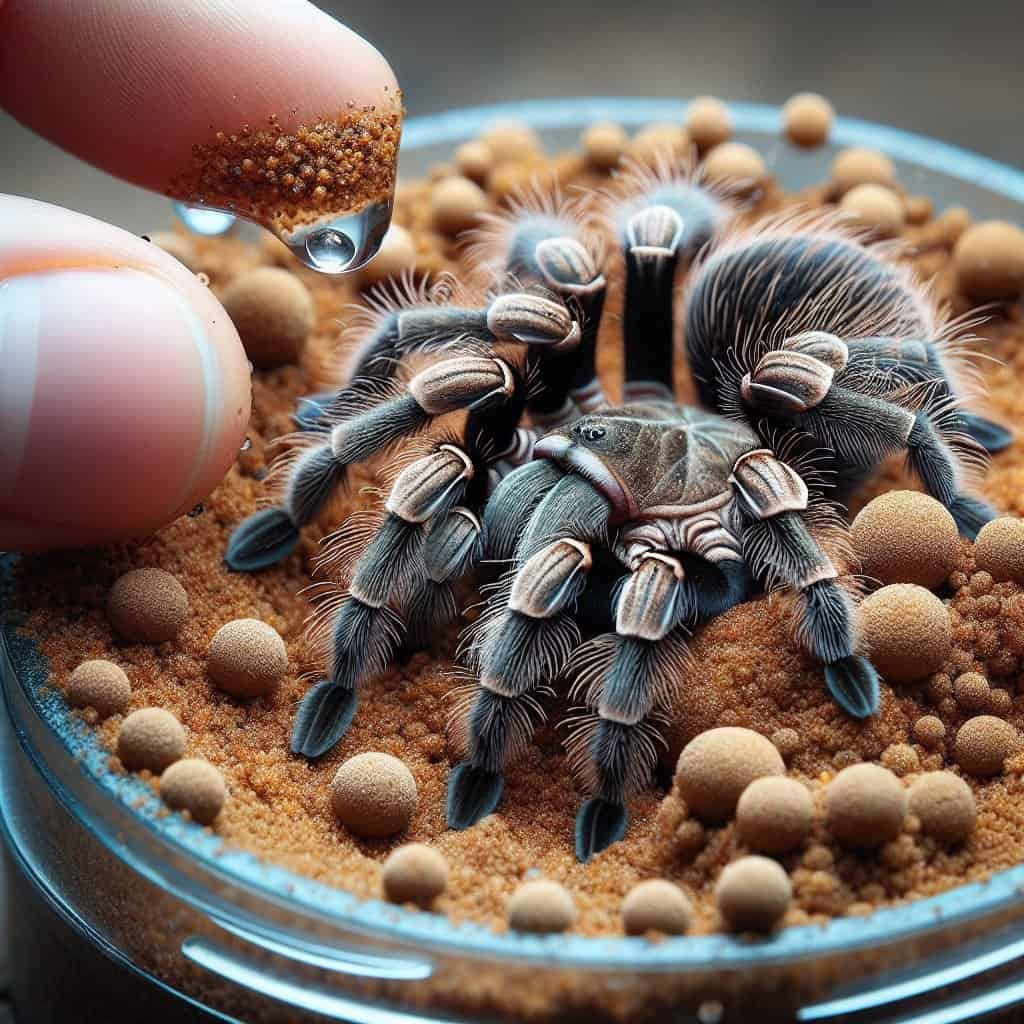If you’re a tarantula enthusiast or considering breeding these fascinating creatures, you may already know that there are numerous factors to consider for a successful breeding process. However, one element that is often overlooked but crucial to the overall success is the substrate. The substrate, or the material used at the bottom of the tarantula enclosure, plays a vital role in providing a suitable environment for the breeding pair and their offspring. In this article, we will explore the importance of the substrate and how it contributes to the success of tarantula breeding. So, grab a cup of tea and let’s delve into the world of tarantula breeding and the significance of substrate choice.

Importance of Substrate
Substrate is an essential component in tarantula husbandry, playing a crucial role in maintaining the ideal environment for successful tarantula breeding. By providing the necessary humidity levels, nesting opportunities, and promoting molting and egg laying, the right substrate can greatly contribute to the overall well-being and reproductive success of your tarantulas.
Maintaining Humidity
One of the primary functions of substrate is to assist in maintaining the optimal humidity levels within the tarantula enclosure. Certain tarantula species require higher humidity levels, while others thrive in drier conditions. Choosing a substrate with good moisture retention capabilities ensures that the humidity levels remain within the suitable range for your specific tarantula species.
Providing Nesting and Burrowing Opportunities
Tarantulas are natural burrowers and providing them with suitable substrate allows them to exhibit their natural behaviors, which is important during the breeding process. A well-designed substrate provides the ideal depth for nesting and enables the tarantulas to create secure burrows where they can feel safe during the breeding process.
Enhancing Egg Laying
A proper substrate helps facilitate the egg-laying process for female tarantulas. By providing a soft and supportive surface, the substrate enables the female to construct a sturdy and protective egg sac. The substrate also plays a vital role in maintaining the necessary humidity for the successful development of the eggs.
Promoting Molting
Molting is a crucial process in the life cycle of tarantulas, and the right substrate can greatly support this process. A suitable substrate allows the tarantula to dig and create a secure molting ground. Additionally, the substrate helps to maintain the necessary moisture levels, ensuring a successful molting process and minimizing the risk of complications.
Types of Substrate
When it comes to tarantula breeding, various types of substrate can be used. Each type has its unique characteristics and benefits, so choosing the right substrate depends on several factors such as tarantula species, environmental conditions, and personal preferences. Here are some commonly used substrates:
Peat Moss
Peat moss is a popular choice due to its exceptional moisture retention properties. It provides a natural and soft substrate, which is ideal for tarantulas that require higher humidity levels. However, it’s important to make sure that the peat moss is free from any additives or chemicals that could be harmful to the tarantulas.
Coconut Fiber
Coconut fiber, often referred to as coir, is another widely used substrate in tarantula breeding. It is a natural and sustainable option, known for its excellent moisture retention capability. Coconut fiber also provides a suitable texture for tarantulas to burrow and create their nesting sites.
Topsoil
Topsoil is a versatile substrate that can be used alone or as a component in a custom substrate mix. It provides good drainage while retaining enough moisture for suitable humidity levels. Topsoil also enables tarantulas to create burrows and nests, mimicking their natural habitat.
Vermiculite
Vermiculite is a lightweight substrate that retains moisture effectively. Due to its porous nature, it allows for proper airflow within the enclosure while ensuring sufficient humidity levels. Vermiculite is often used as an ingredient in substrate mixes to improve water retention capabilities.

Choosing the Right Substrate
Selecting the appropriate substrate for your tarantula’s breeding environment is vital to ensure their well-being and reproductive success. Consider the following factors when choosing the right substrate for your tarantulas:
Consider Species Requirements
Different tarantula species have varying preferences in terms of humidity levels, burrowing behavior, and nesting preferences. Research your specific tarantula species to understand their natural habitat and replicate it as closely as possible with the chosen substrate. This will help create an environment that meets their specific needs and promotes successful breeding.
Avoid Toxic Substances
It is crucial to avoid using substrates that contain any toxic substances or chemicals. These can be harmful to tarantulas and jeopardize their health and breeding success. Always choose substrates that are organic and free from additives or pesticides.
Ensure Proper Moisture Retention
Consider the moisture retention capabilities of the substrate. Tarantulas have varying humidity requirements, and it is important to choose a substrate that can maintain the appropriate moisture levels for your tarantulas’ specific needs. A substrate that retains moisture well can make it easier to maintain a suitable environment for breeding.
Texture and Granularity
The texture and granularity of the chosen substrate should be suitable for burrowing and nesting behavior. Tarantulas prefer substrates that allow them to dig and create tunnels, so choose a substrate that has a fine or granular texture. Coarser substrates may not provide the necessary support for burrowing or egg-laying.
Preparation and Treatment of Substrate
Before introducing the substrate into the tarantula enclosure, it is important to prepare and treat it to ensure the overall health and safety of your tarantulas. Here are some recommended methods for preparing and treating the substrate:
Sterilization
Sterilizing the substrate helps eliminate any potential pathogens or pests that could harm your tarantulas. This can be done by baking the substrate in the oven at a low temperature (around 200 degrees Fahrenheit) for a certain period of time. The exact time and temperature will vary depending on the type and amount of substrate used, so it’s important to research and follow recommended guidelines.
Chemical Treatments
Some keepers prefer using chemical treatments to further ensure the elimination of any potential pests or pathogens. However, it is crucial to choose treatments that are safe for tarantulas and follow the manufacturer’s instructions carefully. Avoid using any chemicals that could be toxic to your tarantulas, and make sure the substrate is properly rinsed and dried before use.
Baking or Desiccation
Another method to treat the substrate is by baking it or exposing it to desiccation. This process involves drying the substrate thoroughly to eliminate any moisture that may harbor bacteria or fungi. Baking it in the oven or leaving it exposed to air for an extended period can effectively achieve desiccation.

Maintaining Substrate
Proper maintenance of the substrate is essential to ensure the overall cleanliness and health of the tarantula enclosure. Regular spot cleaning, prevention of mold and fungal growth, and periodic substrate replacement are key aspects of maintaining a suitable substrate environment.
Preventing Mold and Fungal Growth
Mold and fungal growth can be detrimental to the health of tarantulas and their offspring. To prevent this, it is important to monitor the moisture levels within the enclosure and ensure they remain within the appropriate range for your tarantula species. Adequate ventilation and avoiding over-saturating the substrate can help prevent the growth of mold and fungi.
Regular Spot Cleaning
Regular spot cleaning involves removing any uneaten prey items, molts, or waste from the substrate. This helps maintain a clean and hygienic environment for your tarantulas and reduces the risk of any bacterial or fungal infections. Spot cleaning can be done using a pair of tweezers or by gently sifting through the substrate with your hands.
Periodic Substrate Replacement
Over time, the substrate may break down or become contaminated, warranting a complete substrate replacement. The frequency of replacement depends on several factors, such as the size of the enclosure and the number of tarantulas within it. As a general guideline, it is recommended to replace the substrate every few months or sooner if it becomes visibly soiled or contaminated.
Substrate and Nesting Behavior
Creating an environment that mimics the natural habitat of tarantulas is crucial for successful breeding. The substrate plays a significant role in facilitating natural nesting behavior and providing secure hiding spots for both males and females during the breeding process.
Mimicking Natural Environment
The substrate should resemble the natural ground or soil found in the tarantulas’ native habitat. By replicating their natural environment, tarantulas feel more comfortable and are more likely to exhibit natural nesting behavior, leading to successful breeding outcomes.
Facilitating Sufficient Depth
Tarantulas require a substrate depth that allows them to dig and create burrows for nesting. The depth of the substrate should be at least the leg span of the tarantula to ensure they have enough space to construct a secure nest. The substrate should also provide stability to prevent collapse or disruption of nesting sites.
Creating Hiding Spots
In addition to nesting, tarantulas often seek hiding spots during the breeding process. The substrate should offer various hiding spots, such as small caves or tunnels, where the tarantulas can retreat and feel secure. These hiding spots not only provide privacy but also minimize stress and potential aggression between males and females.

Role of Substrate in Egg Laying
The substrate plays a critical role in the egg-laying process of female tarantulas. By providing suitable conditions for nest building, maintaining proper humidity levels, and preventing desiccation, the substrate significantly contributes to the successful development of tarantula eggs.
Promoting Nest Building
A well-designed substrate enables female tarantulas to construct a sturdy and protective egg sac. Tarantulas may use various materials, such as webbing and substrate particles, to create a secure nest. The substrate should be soft and supportive to aid in the formation and stabilization of the egg sac structure.
Ensuring Proper Humidity for Egg Development
Maintaining the ideal humidity levels is crucial for the proper development of tarantula eggs. The substrate should have excellent moisture retention properties to ensure consistent and appropriate humidity levels within the nest. This helps prevent desiccation and promotes successful egg development.
Preventing Desiccation
Desiccation, or drying out, can be a significant threat to the viability of tarantula eggs. The substrate should effectively retain moisture, preventing excessive evaporation and desiccation of the eggs. Adequate moisture levels within the substrate help ensure the eggs remain hydrated and provide a suitable environment for embryo development.
Substrate Effects on Molting Process
The molting process is a vulnerable period in a tarantula’s life cycle, during which the right substrate plays a crucial role. By assisting in the shedding process, maintaining optimal moisture levels, and providing a secure molting ground, the substrate contributes to the overall success and health of tarantulas during molting.
Assisting in Shedding Process
Tarantulas require a suitable substrate to assist in the shedding of their old exoskeleton. The substrate should allow the tarantula to create a secure molting ground where they can anchor their feet and exert the necessary pressure to shed their exoskeleton successfully. A soft and supportive substrate can make this process easier and minimize the risk of injuries.
Maintaining Moisture Levels
Proper moisture levels are crucial during the molting process as they help facilitate the smooth shedding of the old exoskeleton. The substrate should retain sufficient moisture to prevent excessive drying out of the new exoskeleton, which could lead to complications during molting. Adequate moisture also ensures the elasticity of the exoskeleton, reducing the risk of tearing or constricting the tarantula’s body.
Providing Secure Molting Ground
During molting, tarantulas are more vulnerable to predators and injuries. The substrate should provide a secure and stable surface where the tarantula can safely molt without the risk of falling or being disturbed. A suitable substrate depth and stability help support the tarantula during this critical process and greatly contribute to the overall success of molting.

Substrate Considerations for Each Breeding Phase
Throughout the different phases of tarantula breeding, the substrate requirements may vary. Tailoring the substrate to the specific needs of each phase is vital for successful breeding outcomes. Here are some substrate considerations for each breeding phase:
Breeding Introduction
During the initial introduction of males and females for breeding, it is advisable to provide a substrate that allows easy monitoring and separation if any aggression or mating difficulties arise. A shallow substrate with good visibility can help facilitate observation and intervention if needed.
Egg Incubation
When the female tarantula is preparing to lay eggs, it is essential to provide a substrate that enables her to construct a secure and stable egg sac. The substrate should be soft, supportive, and have good moisture retention capabilities. The depth of the substrate should allow for the ideal depth of the egg sac as determined by the species.
Nurturing Spiderlings
Once the eggs have hatched and spiderlings emerge, the substrate should provide a suitable environment for the young tarantulas to thrive. Substrate depth should be adjusted according to the size of the spiderlings, providing ample space for burrowing and creating hiding spots. A substrate with fine particles can help prevent escape and injury for the small spiderlings.
Common Issues with Substrates
While substrate is crucial for tarantula breeding success, some common issues may arise related to substrate choice or maintenance. Being aware of these issues can help address them promptly and ensure the health and well-being of your tarantulas.
Complications with Mold Infestation
Maintaining proper humidity and ventilation within the enclosure is key in preventing mold and fungal growth. If mold infestation occurs, it is important to address it immediately to avoid any potential health issues for your tarantulas. Adjusting the moisture levels, increasing airflow, and spot cleaning can help mitigate mold growth.
Inadequate Moisture Regulation
Choosing a substrate with insufficient moisture retention capabilities can lead to difficulties in maintaining the optimal humidity levels for your tarantulas. Inadequate moisture regulation can jeopardize breeding success, especially during egg incubation and spiderling rearing. Regular monitoring and adjustment of moisture levels can help mitigate this issue.
Incorrect Substrate Depth
Providing the appropriate substrate depth is crucial for tarantulas to exhibit natural behavior, facilitate nesting, and molt successfully. Inadequate substrate depth can limit their ability to burrow and create secure nests, while excessive depth may lead to unstable burrows or difficulties in molting. Researching the specific needs of your tarantula species can help ensure the substrate depth is appropriate for their requirements.
In conclusion, the substrate plays a significant role in the success of tarantula breeding. By maintaining proper humidity, facilitating nesting and burrowing behavior, promoting molting, and supporting egg development, the right substrate contributes to the overall health, well-being, and reproductive success of your tarantulas. Consider the species requirements, ensure proper moisture retention, and choose a texture that enables natural behaviors. Proper preparation, treatment, and maintenance of the substrate are also essential for a healthy breeding environment. By understanding the importance of substrate and addressing any potential issues, you can create an optimal environment for your tarantulas to thrive and successfully reproduce.
